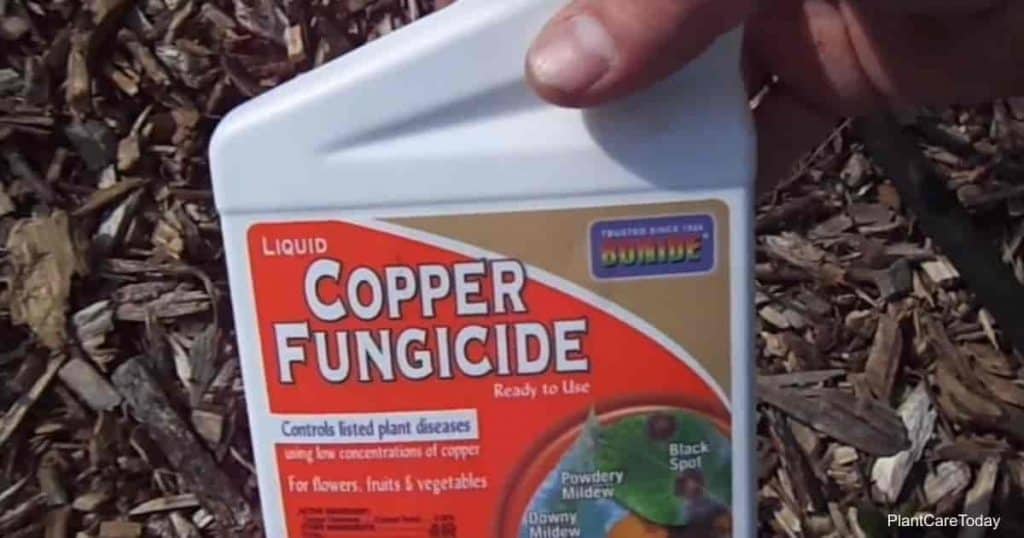In warm, wet weather, fungal disease tends to plague garden plants.
Rather than using dangerous chemical fungicides, many gardeners choose to use copper fungicides.

It may surprise you to know even though it is a metal, copper can dissolve in a way allowing it to penetrate deeply into plant tissues to provide optimal prevention and control of a wide variety of fungal diseases, such as:
When used correctly and at the right time, a liquid copper fungicide provides good protection against these particular diseases, but there are some considerations to keep in mind.
Copper fungicides are important for managing diseases caused by bacteria and resistance developing to other fungicides being used at risk.
Other forms of copper used for plant disease management, such as copper hydroxide, copper oxide, copper oxychloride, and copper octanoate, are formulated to produce low doses of copper to reduce toxicity to plants.
#1 – Limited effectiveness: When using a Copper fungicide, timing is important.
For example, this type of fungicide is not especially effective when used against the late blight of tomatoes and potatoes.
#2 – Toxicity: You must be very careful to follow packaging directions precisely because copper is toxic.
If used incorrectly, it can cause a great deal of damage to plant tissues.
#3 – Varying product results: There are many different types of copper products available, and these vary a great deal in terms of the rate of application and the amount of copper and other active ingredients included.
For this reason, you must review packaging directions every time you use a copper fungicide, especially if you are changing from one product to another.
#4 – Soil contamination: You must use copper fungicide very sparingly because it doesn’t break down in the soil.
Over time, it builds up and becomes a hazardous contaminant.
What Damage or Condition Does Copper Fungicide Control?
It’s important to understand copper fungicide is a deterrent for diseases like bacterial black spot, not a cure.
It’s best to set a regular schedule of use to prevent and control the development of fungal infections.
It will not cure existing infestations.
It may be helpful if you catch a fungal disease (based on early symptoms or conditions) before you see the fungus.
Otherwise, use it as a safeguard early on when weather conditions would predispose your plants to develop fungal disease.
For best control, begin treatment 2 weeks before the disease normally appears or when weather forecasts predict a long period of wet weather.
You may also want to use it as a preventative on healthy plants if you see fungus on one plant or if you have accidentally brought in a plant with a fungal infection.
In this case, you would want to remove the infected plant and treat the rest with copper fungicide.
How and When To Use Copper Fungicide?
How to use copper fungicide? People often ask this.
Generally speaking, you would mix 1 to 3 teaspoons of copper fungicide with a gallon of water to be used as a spray application.
If possible, spray plants when you have at least 12 hours of dry weather following the application.
As noted, these are just general directions. Copper Fungicide controls a large variety of plant diseases, including peach leaf curl, powdery mildew, black spot, rust, anthracnose, fire blight, and bacterial leaf spot.
Use on vegetables, roses, fruits, and turf.
Remember always to read the specific directions for the product you are using every time.
These products tend to degrade within a few days of application, so they must be reapplied for the best results.

Most copper fungicide spray products are applied on a weekly basis. Apply some every ten days.
Pseudomonas syringae isolates resistant to copper have been found on many crops in the PNW, including fruits such as blueberry and pear and ornamentals such as Euonymus, Forsythia, lilac, maple, Mock orange, Mountain ash, Oregon grape, Otto Lueken,
Even though copper spray for plants is not known to be harmful to bees, we must be careful to protect the dwindling bee population in every way possible.
For this reason, you should never apply copper fungicides to plants where bees are actively gathering pollen.
Apply the products late in the day after bees and other pollinators have stopped foraging.
This will give the product time to dry out before it begins hunting for pollen again when the sun comes up.
Improved control of bacterial spot of tomato, halo blight of beans, or walnut blight has been reported from applying a mixture of copper hydroxide and the fungicides maneb or mancozeb.
Copper Fungicide can be used on a variety of listed fruits, vegetables, nuts, herbs, and flowers and can even be applied up to the day of harvest.
When to spray copper fungicide?
The timing for spraying copper fungicide depends on the specific plants and diseases you target.
Generally, copper fungicide should be sprayed preventatively before disease onset or at the first signs of infection.
Follow the copper fungicide instructions provided with the specific product for the best timing and frequency of application.
When in Doubt, Seek Help
Many gardeners swear by copper fungicides to keep fungal infections (anthracnose) under control and protect Hemlock-type plants such as eggplant, potatoes, and tomatoes, as well as squash and cucumbers.
The use of copper fungicides is used in organic gardening is a little bit confusing.
As long as you’re very careful about following the label directions, you should encounter a few problems.
If you have questions about using copper fungicide in your specific situation, contact your County Cooperative Extension Office to find out exactly what is recommended in your area.
Resource: Copper Fungicide Technical Fact Sheet
